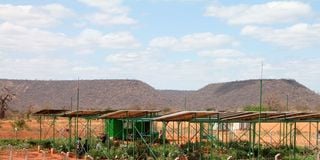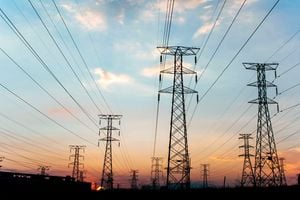Makueni taps into new solar technology to tackle food insecurity

An agrivoltaic farming project at Ngomano Village in Makueni County on September 16. It is used to address water and food insecurity in the arid region.
What you need to know:
- Agrivoltaic farming is the practice of growing crops underneath solar panels.
- It allows for dual land use, combining agricultural production and solar energy generation on the same plot of land.
A set of cascading solar panels mounted on metal structures tower above a farm dotted with cabbages, maize, onion, butternut, cayenne pepper and beans, creating a spectacle in Ngomano village, Makueni County.

Mukai Nzamei, a field officer at Ngomano agrivoltaic project, holds a tomato crop on September 16, 2024.
The oasis, which stands out from the sun-baked neighbourhood, sits at the end of a dirt road that branches off from the Kibwezi-Kitui Road. Multiple QR code marks mounted on the farm and various digital instruments towering above the crops announce loudly that it is not an ordinary farm. Welcome to the future of agriculture based on agrivoltaics, a new concept in climate smart farming which is causing a buzz in America and Europe.
Agrivoltaic farming is the practice of growing crops underneath solar panels. It allows for dual land use, combining agricultural production and solar energy generation on the same plot of land. “This agrivoltaic project investigates the benefits of integrating solar panels on different agricultural structures and exploring the implications on crops grown underneath and the different possible uses of energy produced in the system,” said Tania Pons Allon, the director of Kasser Joint Institute for Food, Water and Energy Security, an Israeli development organisation that has teamed up with Arizona University and the Jewish National Fund to set up the multi-million shillings project billed as the panacea to water and food insecurity.
Agrivoltaic technology involves tapping the sun to grow crops in hostile climatic conditions. The solar panels allow the harvesting of solar energy twice: for generating clean electricity, which is used for powering a water pump to draw water from River Athi that snakes through the area, and providing shade to the crops beneath. Shading of the crops promotes prudent use of water by retaining soil moisture.
Although it is barely a year old, the Ngomano agrivoltaic project has excited the local community. “We used to think cabbages only thrive in other regions. We had resigned to cow peas and okra as the preferred vegetables. This notion has since evaporated after we watched cabbages thrive and curl neatly beneath the solar panels. The solar project has also taught us that drip irrigation saves farmers a lot of water and the money needed to pump water compared to basins and furrow irrigation, which we use in this region," said Mukai Nzamei, a nursery school teacher at Ngomano Primary School who doubles up as a field assistant at the agrivoltaics research site.
In addition to tending the crops under study, her work entails monitoring the root moisture and water meter sensors, which measure the amount of water used by the crops, to ensure that they are working optimally.
“After harvesting cayenne pepper, I count the yields from every crop, weigh them separately and record the measurements against the unique identities of the crops. We use the QR codes to relay the information to researchers in America".
According to Ms Allon, the Ngomano agrivoltaic project, which is the first one of its kind in the country, is set to benefit Ngomano Primary School and some 252 households in the region nestled by rivers Athi and Yu. A key component of the project is the dissemination of good agricultural practices backed by science to farmers. The project has restored hope in the sleepy region which once produced the bulk of the country's cut flower exports until 40 years ago.
Today, residents still rummage for valuables at the ruins of what used to be the staff quarters at DCK, the Danish company which operated the flower farm. It folded up in 1980s under unclear circumstances. A local company which produced baby corn in the same region for the export market folded up in 2008 after a short stint punctuated by over-abstraction complaints. It reportedly cited a drastic reduction in the levels of water at River Yu, which was its main lifeline.
The Ngomano agrivoltaic project has taken root at a time USAID, World Bank and other development partners with interests in Makueni County have turned to nature-based solutions to battle the climate crisis.
Makueni’s devolved government has rolled out an aggressive environmental conservation campaign aimed at building the resilience of communities to drought and other effects of the changing climate. The government has embarked on scaling down the use of grid electricity and diesel generators to pump water from its dams and boreholes by installing solar systems on the water sources as part of a Sh73 billion county energy plan, which is big in tapping the sun to unlock the county's economic potential by spurring agribusiness and industrialisation. The plan also entails solarisation of hospitals, institutions and factories such as the Makueni Fruits Processing Plant that process mangoes into puree and ready-to-drink juice. “As the country strides to promote food production and reduce over-reliance on rainfed agriculture, we require reliable energy to power irrigation systems. Interventions in these areas will significantly contribute to food security, create jobs and reduce our poverty levels,” Makueni Governor Mutula Kilonzo Junior said while unveiling the energy plan recently.
Scientists hail agrivoltaic technology as a viable solution to food insecurity in the wake climate change. “Studies have shown that it is very expensive to rely on diesel and petrol generators in irrigation. Using solar energy in irrigation not only makes the farming venture sustainable but also reduces the flow of greenhouse gases into the atmosphere associated with using diesel and petrol generators. Using drip irrigation systems and the shading of the growing crops using solar panels promotes prudent use of water and ultimately prevents over-abstraction of water sources such as rivers,” said Jenipher Masawa, an ecologist who works as the field manager at Ngomano agrivoltaic project.
The United Nations Environment Programme (Unep) urges the use of nature-based solutions principles when deploying sustainable food systems projects such as the agrivoltaic technology. “Such projects should concurrently address the triple planetary crisis of pollution, climate change and loss of nature and biodiversity. Water and soil management, including the responsible use of fertilisers and other farm inputs, are essential,” said Levis Kavagi, the regional coordinator of Ecosystems and Biodiversity Programme at Unep.





